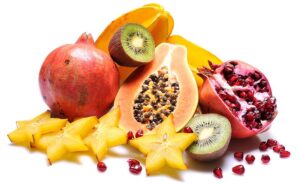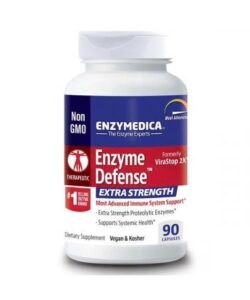A few months ago I wrote about various anti-virus protocols. One was good for both acute and chronic virus infections (COVID, influenza and genital herpes, as examples). I’m in the mood to talk a bit further about this: enzymes as a health tool!
You already appreciate that viruses are very simple in construction; just bits of genetic material (DNA and RNA) wrapped in a protein protective coat. What if we were to strip off the protein coat? The virus would be rendered non-viable or, at the very least, be exposed to murderous attack and destruction by the host’s immune system!
Any questions? Good.
So how do we remove the protein outer layer? It’s so obvious, you would probably kick yourself, if you don’t already know. We digest it away, using digestive enzymes, just like the ones in your intestines!
We can actually swallow the enzymes, they will get into the blood, circulate throughout the body, and eventually reach the viruses wherever they are skulking. Boom! End of virus. It’s THAT simple!
Are you ready to “eat” viruses? Great.
What Do We Mean By Enzymes?
Enzymes are a special class of substances that help facilitate change. They speed up chemical reactions, or cause reactions to take place which otherwise would not occur. The substance on which the enzyme works, usually very specific, is called the substrate and the chemical change which takes place is also a very precise one.
In other words, an enzyme which digests lactose (milk sugar) will not digest starches, fats or proteins. It’s one enzyme—one job.
The resulting speeding-up process is known as catalysis. Examples of enzymes are those which cause blood clotting, detoxing chemicals, the fermenting of wine, leavening of bread, curdling of cheese, and brewing of beer.
A number of inherited human diseases, so-called inborn errors of metabolism, result from a deficiency of a particular enzyme. Examples include albinism and phenylketonuria, deficiencies of tyrosinase and phenylalanine hydroxylase respectively.
One of the most important groups of enzymes to us are those which aid the process of digestion. Without them, we would have to wait after swallowing food, until the meal decomposed and went rotten (putrefaction). Apart from being revolting, that would take too long.
Instead we have enzymes which are secreted in the mouth, in the stomach and in the small intestine (not so much in the colon or large intestine). These cause food to be rapidly decomposed into smaller chemical units, which are then easily absorbed.
Usually, enzymes are classified by the target substance on which they act (the substrate). So digestive enzymes are grouped as follows:
Amylase (breaks down amylose and other starches), sucrase (sucrose), maltase (maltose), lactase (lactose, aka. milk sugar), lipase (fats and oils) and proteases (proteins).
There are many subdivisions. For example proteases can be sub-divided into pepsin (in the stomach), trypsin and chymotrypsin (pancreas) and serropeptidase (produced by bacteria).
Then there are digestive enzymes from outside sources: such as molds, yeasts, seaweed and fruits! Mixed with your food, either as part of the recipe, or separately, these too can help with the digestion of meals.
You may have heard of these fruit enzymes: papain from papaya, bromelain from pineapple and actinidin from kiwi fruits. There are other plant proteases.

The whole process of digestion is complex and multifactorial. Fortunately, we do not need a nutritional diploma to get to the point, which is that protein-digesting enzymes will damage or kill viruses (and bacterial biofilm, incidentally), by stripping away the protective protein envelope or outer layer.
Some viruses are coated with layers which include fats and carbohydrates, so it’s best to include a mixture of digestive enzymes, not just the proteolytic ones.
Where is The Science?
This all sounds like a whacky idea. Is there any support for it? You bet. Mainstream science may not be taking much interest in cheap, simple virus remedies—especially when there are $billions to be made from vaccines (whether effective or not) and hugely expensive anti-virals (like acyclovir and remsdevir), some of which are more deadly than the disease they purport to treat.
But there has been a steady background of interesting research, by those not fettered by Big Pharma funding.
We now know that digestive enzymes DO WORK against most viruses. In 1995 Dr Billigman studied the effects of enzyme therapy against Herpes zoster, a tough nut to crack (chicken pox and shingles). He showed enzymes were AT LEAST as effective as the drug acyclovir ($250 – $300 for a 7-da7 course).
Once digested, the body eliminates the virus through its inherent systems of purification and elimination. Recent research also indicates that the oral proteases bound to plasma proteins are able to break down protein-based pathogens in the blood. This includes viruses, fungi such as candida, bacteria and parasites.
Proprietary Formulas
Virastop by Enzymedica is a simple no-brainer. It’s reputation as a virus healer is unsurpassed. HUT (potency) = 150,000 HUT.
ViraStop 2X employs a unique ultra high potency blend of protease enzymes in place of the herbs and nutraceuticals found in many products in the wellness category. ViraStop 2X
employs a unique ultra high potency blend of protease enzymes in place of the herbs and nutraceuticals found in many products in the wellness category. ViraStop 2X contains Enzymedica’s Thera-blend
contains Enzymedica’s Thera-blend of eight different proteases chosen for their unique proteolytic abilities.
of eight different proteases chosen for their unique proteolytic abilities.
Today it is known as Enzyme Defense Extra Strength (I presume to ward off the devil of the FDA). You can get it from Johnsons Compounding and Wellness.
Enzyme Defense Extra Strength is non-GMO, vegan and kosher!
Take 2 capsules a day, between meals. The latter is important, otherwise the enzymes are wasted on digesting your food instead of viruses! You can go to higher doses if you are on a regimen of enzymes but don’t go it alone. Seek advice.
Home Made Enzyme Formulas
Lots of people on the internet today are teaching how to make enzyme concoctions and drinks at home.
It’s easy:
Making a fruit enzyme drink follows a relatively simple procedure; you just need patience, to wait a week for the mixture to undergo fermentation and release the fruit enzymes for consumption! The best fruits to use to make an enzyme drink are citruses like lemons, limes, grapefruits and oranges. Pineapple and papaya are also great additions to your homemade enzyme drink.
Extracting bromelain enzymes, lemon enzymes and papaya enzymes by the process of fermentation requires the presence of sugar in the form of cane sugar crystals or even honey. You also need to add yeast that digest the sugars in the fruit and so extract their enzymes.
To prevent unhelpful bacterial contamination, you need to properly sterilize all the equipment used in the process.
You can actually buy fermented fruit formulas, if you can’t be bothered making your own!
These are good, healthy daily drinks. But for tackling a serious virus burden, you do need formulated enzymes!
To your good health,
Prof. Keith Scott-Mumby
The Official Alternative Doctor
The post Chewing On Viruses – A Good Habit appeared first on Dr. Keith Scott-Mumby.

